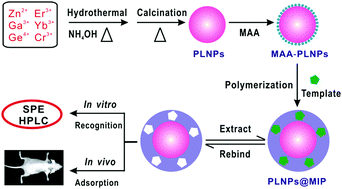Construction of molecularly imprinted nanoplatforms with persistent luminescence for the in vitro specific adsorption and in vivo targeted regulation of food-borne biotoxins†
Abstract
Food-borne biotoxins have become one of the most significant concerns of food-safety; therefore, both the in vitro determination and in vivo regulation of the food-borne biotoxins are of great importance. In the present study, a persistent luminescence nanophosphor-involved molecularly imprinted nanoplatform (PLNP@MIP) was well-constructed for both the in vitro and in vivo investigations of the food-borne biotoxins. This PLNP@MIP core–shell structured nanoplatform demonstrated the in vitro recognition performance and in vivo tracing function to the respective target biotoxin, integrating the specific matching and binding capability of MIP and autofluorescence-free bioimaging ability of PLNPs. The triple-doped zinc gallogermanate (ZGGO) nanophosphors were introduced as the emission core, showing super-long afterglow, excellent stability and biocompatibility, low toxicity, and intense NIR luminescence. The MIP shell coating onto the PLNPs was performed via precipitation polymerization using methacrylic acid (MAA) as a monomer, ethylene glycol dimethacrylate (EDMA) as a cross-linker, and 2,2′-azobis(2-methylpropionitrile) (AIBN) as an evocating agent, which was universal for three target biotoxins. The well-characterized PLNP@MIP possessed a typical core–shell structure, relatively uniform nanosize, highly selective recognition capability, and adsorption capacity. With the assistance of background-free in vivo persistent luminescence imaging and NIR-LED re-activability, the imprinting nanoplatform not only could realize the highly sensitive and selective determination of target biotoxins by MIP-SPE preconcentration from specific samples, but also demonstrated great potential for the real-time tracing of the target biotoxin inside a living body, so as to provide more accurate and in situ information about the hazardous mechanisms and damaging behaviors of biotoxins that originated from food.



 Please wait while we load your content...
Please wait while we load your content...